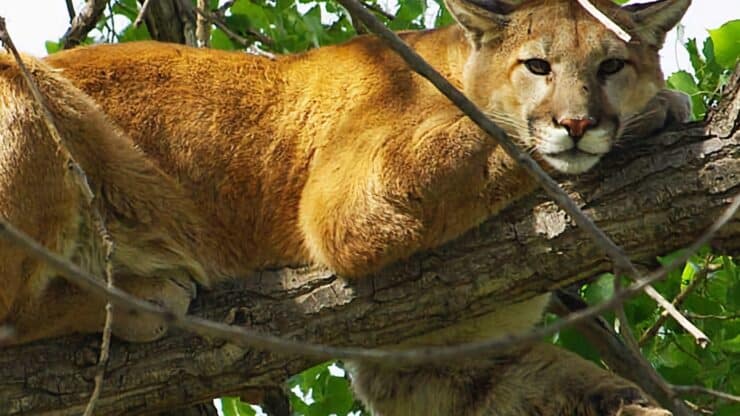
Understanding Mountain Lions When Hiking
One of my most asked questions is "do I have to worry about mountain lions when I hike?" The answer is no and yes. 99.99999% of the time, mountain lions keep their distance from humans and avoid hikers. But it makes sense to be aware of them and their behavior, and be prepared for anything that could occur.
- Avoiding mountain lion attacks
- What to do if you're attacked
- Gear to help fend off mountain lions
- Spotting signs of mountain lion activity
To start, I've never been attacked by a mountain lion. After thousands of hours on the trail, I've never even seen one. That should be your goal too. This article goes over how to understand mountain lion behavior, what to look for to spot their activity, and what to do if you encounter one.

I spent some time interviewing Lauren Serrano and Kelly Andersen at the Orange County Zoo, where they have two adult mountain lions in captivity (orphans rescued at birth). Lauren and Kelly went into detail to answer your questions about mountain lions and how to enjoy the outdoors in mountain lion country. And FYI, mountain lions, cougars, pumas, and Florida panthers are all the same thing.
Let's start by getting the most dramatic scenarios out of the way first.
How To Stop a Mountain Lion Attack
If a mountain lion attacks you, you probably won't see it coming. Even though they're big, they're also very quiet, and will generally stalk and pounce. But sometimes you will see them when they're curious and maybe sizing you up to determine if you're prey.
If you are lucky enough to see the mountain lion before it's on you, DO NOT RUN AWAY OR TURN YOUR BACK TO IT, as these are signals that you are prey. Mountain lions normally eat things like deer and sheep, but will eat anything from mice to elk. They eat about 10 pounds of meat a day, and only eat meat. You want to show it that you are not prey and you are not scared. And FYI, you cannot outrun a mountain lion, they can run up to 50mph.
Here's what you should do:
- Put your hands in the air, make noise, and act bigger than you are.
- If you have trekking poles, raise them up too and get ready to use them if it approaches you.
- If you have an air horn, give that some blasts.
- If you have bear spray, get ready to let it loose if the mountain lion approaches. It works on mountain lions too.
- Wave sticks, wave your pack, whatever you can do to look scary.
- Don't antagonize it. Some people say not to look it in the eye, but there's nothing empirical about that advice. Just don't come at it, corner it, or antagonize it in any way.
Here you can see a trail runner fending off mountain lions with bear spray. It's a great tool to have with you. Also note that he's running, which makes him seem like prey.
In this next video, you can see a hiker who encounters a mountain lion sitting on the trail. He does all the right things and the mountain lion leaves him alone. You can see that once the mountain lion realizes he's not prey, it's quickly lost interest.
And lastly, check out these hikers who are stuck with a mountain lion on a fenced walkway. This one really hits home the point that if the lion knows that you're human, they generally don't want anything to do with you.
If you do spot a mountain lion, proper etiquette is to report it to a ranger. If you have reception, call it in from the spot, if not, call the ranger when you're done your hike.
What To Do If a Mountain Lion Attacks You
Usually the previous steps will do enough to convince the mountain lion that you're not a deer, and scare it off. If it does start to charge you, use any of the tools previously mentioned to start swinging at it. Or shoot at its face with bear spray.
If a mountain lion really wants to attack you, you probably won't see it coming. Ideally they'll ambush you and try and crush the back of your neck with their bite. Not a good situation to be in.
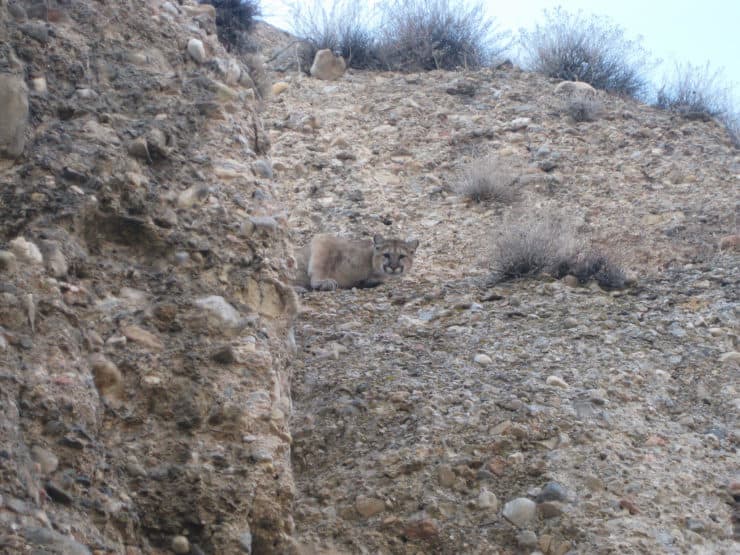
If you do find a mountain lion attacking you, here's what to do.
- Try to grab something to fight back with. A women in Northern California fended off an attack with a ballpoint pen. Grab a knife, a GPS, a rock, a stick, anything hard that you can hit with. If you don't have anything, use your fists.
- Start hitting the animal in the head, specifically the eyes. The longer you can punch, hit, and fight it off, the more you will convince the mountain lion that you're not worth the effort.
- If you do have bear spray clipped on your pack, and you haven't discharged it, do it now directly into the mountain lion's face.
- Focus on nothing other than surviving and hitting back. Take it one hit at a time. Tell yourself that people have survived this and you can too.
- If you find yourself behind the lion when grappling around, you can also try to choke and suffocate it. Whatever works.
If your companion is being attacked, apply those same principles and attack the lion. There are many accounts of a second person successfully scaring a mountain lion off of a companion.
Gear to Survive a Mountain Lion Attack
If you're really terrified of getting attacked by a lion, I would highly recommend clipping bear spray and a straight blade knife to your backpack straps, ready to be deployed if you're rolling around on the ground with a mountain lion. Personally, I think this is overkill, but I understand the power of fear (and the power of mountain lions)!
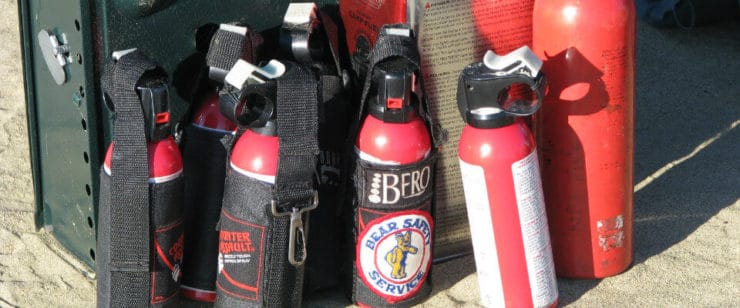
My personal strategy is to avoid attacks and then be vigilant if I see signs of activity (see below). If I do think there are mountain lions active where I'm hiking, I'll clip bear spray and a knife to my pack, and will hike with trekking poles.
Some folks also bring an air horn (like you'd find on a boat). You can pick one up in any hardware store, Walmart, etc., which makes it a good option.
How to Avoid a Mountain Lion Attack
While I haven't ever encountered a mountain lion on the trail, I have seen plenty of signs of their presence. Mountain lions live anywhere and everywhere there is prey, with the greatest concentration in the western half of the USA and Canada. They're in the deserts, they're in the mountains. So assume they could be anywhere. Many ranger offices are good about posting notices and signs at trailheads in areas where they are active.
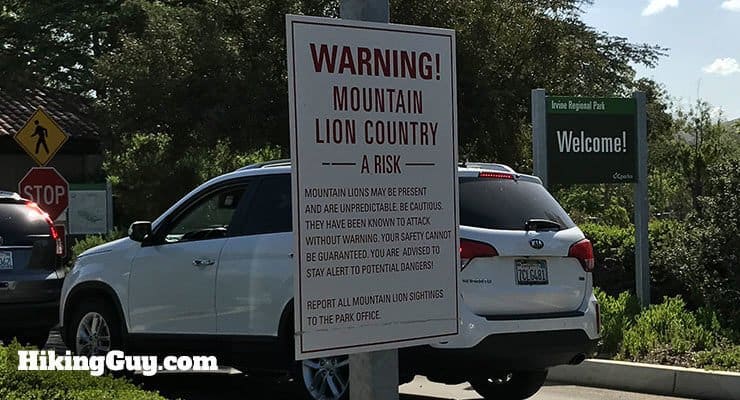
The key to avoiding a mountain lion attack is to be aware of signs that they've been active where you are. If you see a sign that there might be one in your area, take your trekking poles out, get your spray ready, and be extra alert. I like to sing out loud and make a lot of noise too, which is also good at keeping humans away. The average range of a mountain lion is 30 square miles, so even if you see signs, it could be miles away from you.
Signs of Mountain Lion Activity
Here are the signs that put me on extra alert for mountain lions:
- Seeing deer, sheep, or other bigger animals that would be mountain lion prey.
- Seeing a dead animal carcass, especially a fresh one. Mountain lions have no problem feeding from a carcass, whether they killed it or not.
- Seeing fresh mountain lion scat. The problem is identifying it. In general, it can be big, almost the size of human poop, especially in circumference. Sometimes it will have hair from the prey in it. If it's dry, it's old, if it's moist and warm, it's probably new.
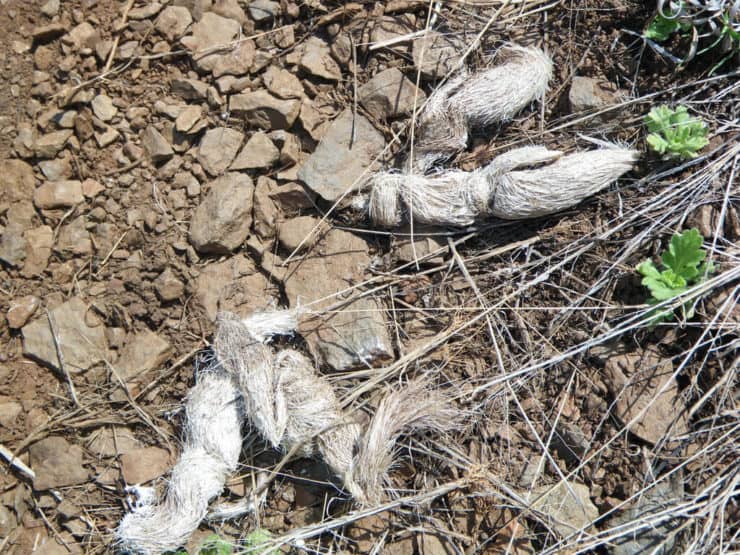
Here's an example of older scat with hair from prey in it. In this case, the scat is old and the mountain lion is probably long gone. Photo from Alan English - Seeing fresh mountain lion tracks puts me on alert too. Unless you have experience in tracking, or you see a paw print in snow, it will be hard to tell how fresh the track is. Either way, just seeing tracks means that the lion has been where you are and could come back. Their paw print is about 2" tall by 4" wide, and doesn't have claw/nail prints (dogs do). You can also tell them apart from dog tracks by looking at the top toe. If one toe is in front of the others, it's a cat. If both top toes are level, it's a dog. There are exceptions but that's a good general rule. A mountain lion's hind foot steps in his front track, creating overlapping patterns too.
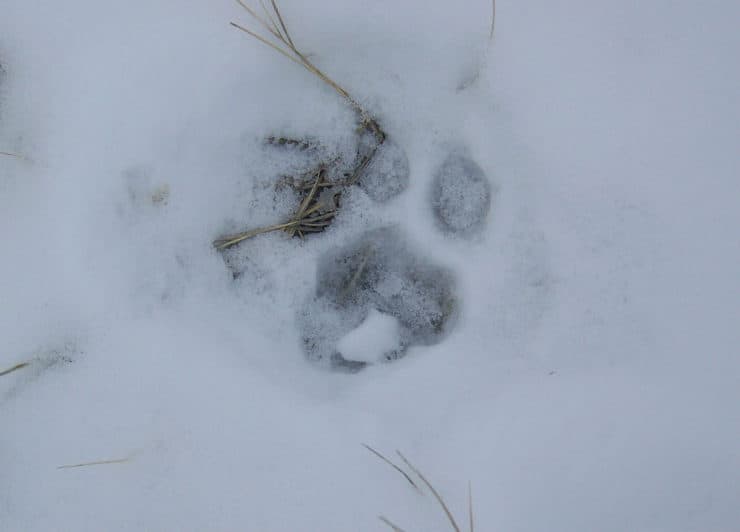
Here's a mountain lion paw print in the snow. Notice the absence of any claws and a leading toe (second from left). Photo from US Fish and Wildlife Service
Being Vigilant When Resting
We talked about mountain lions preferring to attack something that's smaller or easier to kill. When you crouch or sit down, you become a much more attractive target for them, and it triggers their natural instinct to attack. Check out this video of the principle in action at a big cat rescue facility.
In a fatal attack near my home, it was believed that the mountain lion attacked a mountain biker when he was crouched down to put the chain back on his bike. Crouching is bad.
I realize it's tough to never crouch or sit down, and that's not what I'm suggesting. When I'm camping, sitting around a campfire, am I constantly thinking that a mountain lion will jump on me? No. But I do try and be extra aware, especially I know that mountain lions are active. And if you're in your tent, you're probably fine.
Dogs and Kids Are Targets
Because kids and dogs are small and look like easier prey, you need to take some extra steps.
Keep your kids close to you when hiking, and don't let them wander off at night. If you do see a mountain lion, you want to grab your child and pick them up or keep them close to you. It will help you look bigger.
For dogs, there are two schools of thought. The first is that a dog has more awareness than people and will alert you if a mountain lion is near, and might even scare the mountain lion off. Check out this video of a coyote doing just that.
The other school of thought is that dogs are a lot like coyotes, which mountain lions can eat. If you keep the dog on a leash, it will alert you to danger but you can also pull it in close to protect. A person and a dog close together probably doesn't look like prey to a mountain lion.
Being Practical About Mountain Lion Attacks
I realize mountain lions are scary. Should it stop you from hiking or enjoying the outdoors? Absolutely not. If you read this article, you have the tools to successfully coexist with mountain lions in the wilderness. If you want to get empirical about your chances, it's pretty interesting.
- Between 1986 and 2014, there were only 14 verified mountain lion attacks on humans in CA.
- You have a much better chance of dying while driving to the trail, with 36,000 Americans dying in motor vehicle accidents every year.
- You also have a better chance of unintentionally poisoning yourself, with 42,000 Americans dying from that. I'm sure I've come close when drinking gas station coffee on those early morning hikes.
Cover photo from Justin Shoemaker
 Hiking For Beginners: 11 Essential Tips
Hiking For Beginners: 11 Essential Tips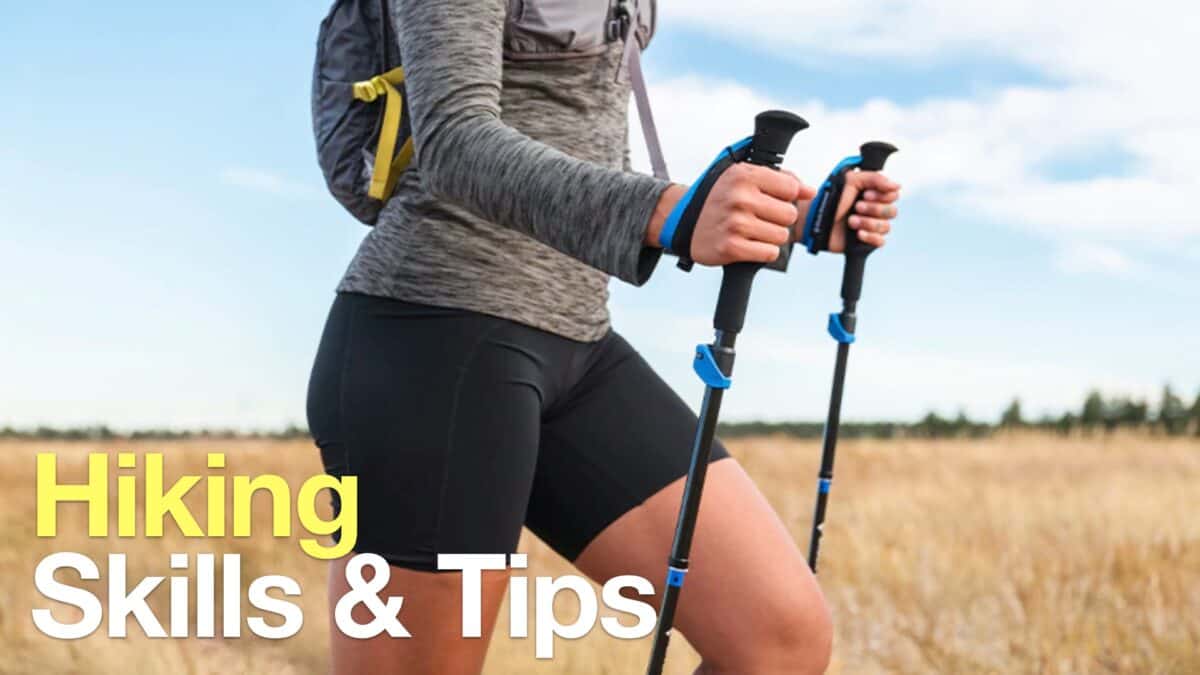 How to Hike
How to Hike Best Hiking Gear 2024
Best Hiking Gear 2024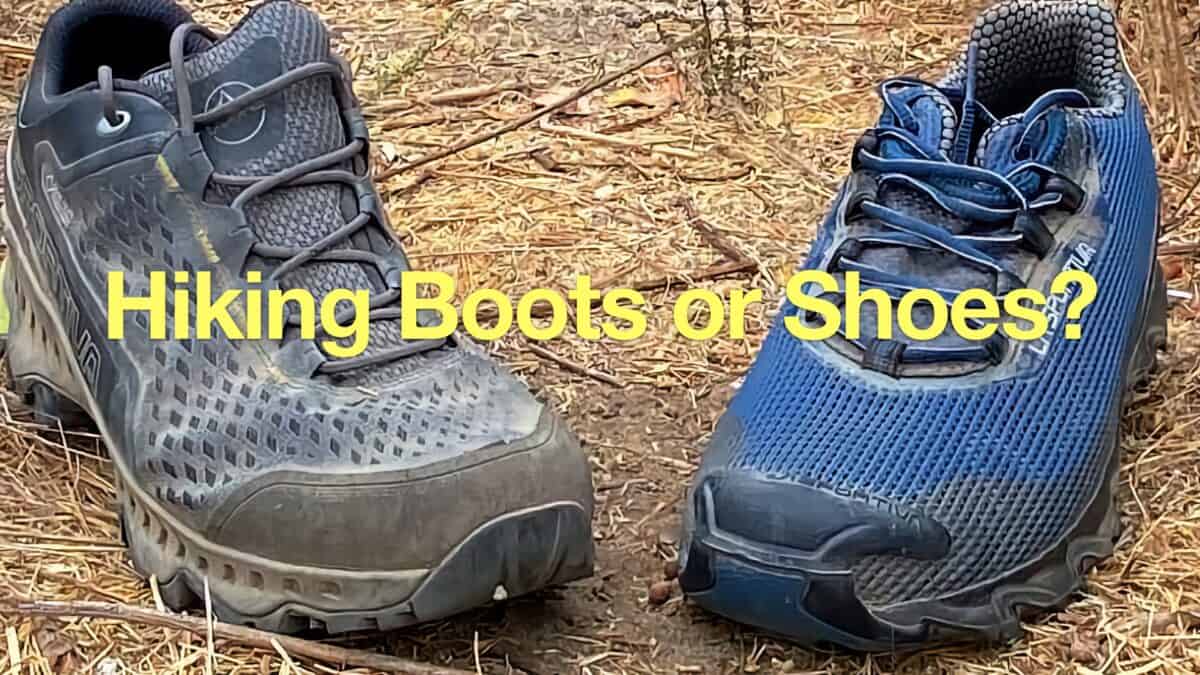 Hiking Boots or Shoes: Do I Really Need Hiking Boots?
Hiking Boots or Shoes: Do I Really Need Hiking Boots?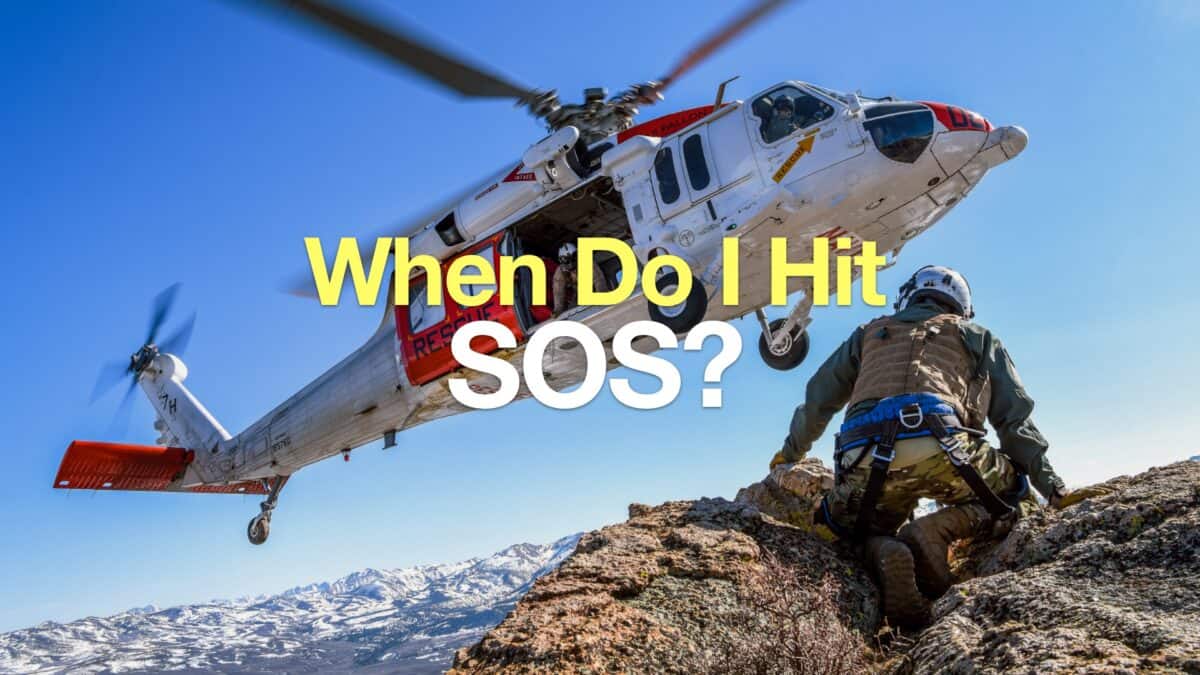 When to Hit SOS on inReach
When to Hit SOS on inReach